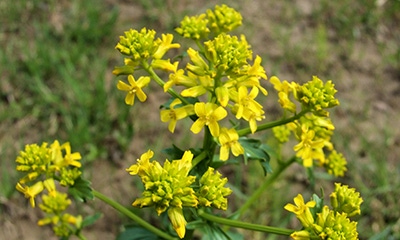May 10, 2016

Ah, spring! Your pasture grasses are lush and growing. But wait! What are those unauthorized plants popping up – that won’t make good feed?
If you were unable to control winter annuals and biennials last fall, the time to get it done is now, suggest Bill Curran and Dwight Lingenfelder, Extension weed specialists at Penn State University. However, herbicide application (or mowing) timing is critical and can make the difference between an effective tactic and a waste of time and money.

PASTURE PRETTY – NOT!: Yellow Rocket, a weed that’s popping up a lot in permanent pastures, is a clue your grazing mix is losing ground.
Once those weeds are in the “setting seed” stage, a herbicide application won’t be effective. The seeds will most likely continue to develop and be viable for a new and more populous generation. So consider these recommendations:
* Winter annuals, including yellow rocket and many of the other mustard species, common chickweed, marestail, fleabane, annual bluegrass, downy brome, etc., are growing rapidly and have already or will begin to flower and set seed very soon.
* Biennials, including musk and plumless thistle, burdock, wild carrot, etc., should be treated before they begin to bolt. They may be bolting now or will do so very soon. The smaller the weed, the better the control. Late fall or early spring is really the best time to treat them.
* Control summer annual weeds as soon after they emerge as possible when they’re most sensitive to chemical control. The most common herbicides used for control of many broadleaf weeds in grass hay/pasture this time of year are plant growth regulator herbicides such as 2,4-D, dicamba (Banvel, Clarity, etc.), triclopyr products (Crossbow, Garlon, etc.), and clopyralid (Stinger, PastureGard, etc.).
In addition, products containing metsulfuron (Cimarron, other generic formulations, etc.) can provide good control of many broadleaf weeds in the spring. Be cautious, if forage grasses were recently seeded and aren’t yet established. Many of these herbicides can cause severe crop injury.
For more details, see the Penn State Agronomy Guide or the 2016 Mid-Atlantic Field Crop Weed Management Guide.
Control guidelines for problem pasture weeds
Missed your early spring window for controlling pasture weeds? Here are a few what-to-do-now tips from Curran and Lingenfelder:
* Winter annuals: (Mustard species, common chickweed, etc.) Mow after bolting to prevent seed production. Apply an effective herbicide in fall or spring – before bolting. Preventing seed production prevents spread. Most winter annuals emerge by late fall;- a smaller percentage emerge in early spring.
* Summer annuals: (Pigweed species, common lambsquarters, common ragweed, etc.) Keep pasture full and competitive. Mow after bolting to prevent seed production. Apply an effective herbicide in early summer. Again, prevent seed production to prevent spread.
* Biennials: (Common burdock, bull and musk thistle, poison hemlock, etc.) Mow after plants have bolted but before seed set to prevent seed production. Remove or dig individual plants by hand. Apply an effective herbicide to rosettes in the spring or fall.
You May Also Like




